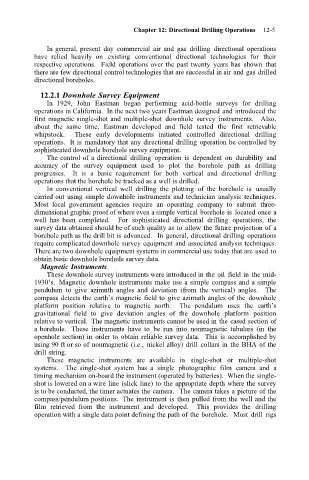Page 641 - Air and Gas Drilling Manual
P. 641
Chapter 12: Directional Drilling Operations 12-5
In general, present day commercial air and gas drilling directional operations
have relied heavily on existing conventional directional technologies for their
respective operations. Field operations over the past twenty years has shown that
there are few directional control technologies that are successful in air and gas drilled
directional boreholes.
12.2.1 Downhole Survey Equipment
In 1929, John Eastman began performing acid-bottle surveys for drilling
operations in California. In the next two years Eastman designed and introduced the
first magnetic single-shot and multiple-shot downhole survey instruments. Also,
about the same time, Eastman developed and field tested the first retrievable
whipstock. These early developments initiated controlled directional drilling
operations. It is mandatory that any directional drilling operation be controlled by
sophisticated downhole borehole survey equipment.
The control of a directional drilling operation is dependent on durability and
accuracy of the survey equipment used to plot the borehole path as drilling
progresses. It is a basic requirement for both vertical and directional drilling
operations that the borehole be tracked as a well is drilled.
In conventional vertical well drilling the plotting of the borehole is usually
carried out using simple downhole instruments and technician analysis techniques.
Most local government agencies require an operating company to submit three-
dimensional graphic proof of where even a simple vertical borehole is located once a
well has been completed. For sophisticated directional drilling operations, the
survey data obtained should be of such quality as to allow the future projection of a
borehole path as the drill bit is advanced. In general, directional drilling operations
require complicated downhole survey equipment and associated analysis techniques.
There are two downhole equipment systems in commercial use today that are used to
obtain basic downhole borehole survey data.
Magnetic Instruments
These downhole survey instruments were introduced in the oil field in the mid-
1930’s. Magnetic downhole instruments make use a simple compass and a simple
pendulum to give azimuth angles and deviation (from the vertical) angles. The
compass detects the earth’s magnetic field to give azimuth angles of the downhole
platform position relative to magnetic north. The pendulum uses the earth’s
gravitational field to give deviation angles of the downhole platform position
relative to vertical. The magnetic instruments cannot be used in the cased section of
a borehole. These instruments have to be run into nonmagnetic tubulars (in the
openhole section) in order to obtain reliable survey data. This is accomplished by
using 90 ft or so of nonmagnetic (i.e., nickel alloy) drill collars in the BHA of the
drill string.
These magnetic instruments are available in single-shot or multiple-shot
systems. The single-shot system has a single photographic film camera and a
timing mechanism on-board the instrument (operated by batteries). When the single-
shot is lowered on a wire line (slick line) to the appropriate depth where the survey
is to be conducted, the timer actuates the camera. The camera takes a picture of the
compass/pendulum positions. The instrument is then pulled from the well and the
film retrieved from the instrument and developed. This provides the drilling
operation with a single data point defining the path of the borehole. Most drill rigs

